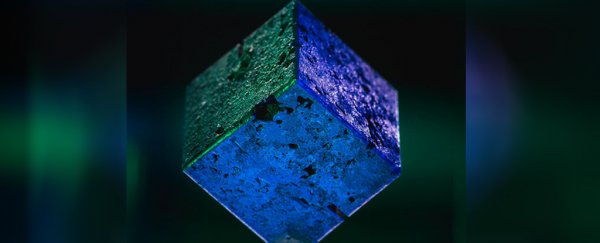It doesn't look like much. A cold, pock-marked block of benign uranium small enough to hold in your hand.
But that tiny metal cube holds a secret to a dark world that might have been, one that University of Maryland physicists Timothy Koeth and Miriam Hiebert have realised was perhaps a little closer than we suspected.
The cube came into Koeth's possession more than five years ago, wrapped in paper towel and accompanied by an intriguing note.
"Taken from the reactor that Hitler tried to build," it said. "Gift of Ninninger."
This 'gift' of 2 kilograms (5 pounds) of uranium squeezed into a block measuring a mere 5 centimetres (2 inches) across is not the sort of artefact you'd expect to hold Nazi secrets.
That's just what its mix of long-degraded radioactive isotopes is though – a record of Nazi technology.
"It's surprisingly heavy, given its size, and it's always a lot of fun to watch people's reaction when they pick it up for the first time," said Hiebert.
There should be more of them around the world. A lot more. As many as another 663 cubes just like it, in fact, were all produced as part of a Nazi Germany's nuclear physics program in the early 1940s before being confiscated in a daring allied mission.
Some have certainly been destroyed. The whereabouts of a handful are known, but it's almost a sure bet that they aren't alone. So Koeth and Hiebert have gone hunting for more. And what they've found sheds new light on how close but yet still how far Nazi Germany really came to a nuclear program.
The German experiment
In 1939, German chemists Otto Hahn and Fritz Strassmann made a landmark discovery. Bombarding uranium with neutrons could transform the material into a smaller element, barium.
This ' fission' of an atom changed the world forever. In the west, the Manhattan Project honed research on fission technology to create a formidable weapon that shocked Japan into surrender at the end of the Second World War. As a fuel source, it now generates some 14 percent of the world's electricity supply.
The rest of the world's story is a little more obscure.
Germany continued to pursue its own goal of transforming this potent source of power into something practical. If only they knew then what we know today, the outcome of the Second World War might have been very different.
So why is it so hard? To shed extraordinary amounts of power, those uranium atoms need to sustain their own splitting. As one atom breaks it sheds neutrons that in turn cause other atoms nearby to fall apart.
Not all flavours of uranium do this. Some isotopes are busting to pop, while others can soak up neutrons and transform in ways that don't contribute to the party. What's more, for neutrons to work their magic, they need to be slow enough to be absorbed.
It took 'the West' years to fine tune this research and determine the right balance of isotopes and critical mass of uranium required to turn garden variety radioactive material into a shocking source of destruction.
In April, 1945 – just three months before the world saw the first nuclear bomb test detonate in New Mexico – an allied mission into Nazi Germany discovered just how far behind the enemy was.
As a part of a mission codenamed Alsos, the run behind enemy lines uncovered an experimental laboratory in the town of Haigerloch run by the renowned physicist Werner Heisenberg. German scientists had frantically dismantled the lab, but buried nearby were those historical uranium cubes.
How one made its way into Koeth's hands would be a tale all of its own. What some might have seen as spoils of war others would see as valuable uranium fated for future military use, meaning the samples have long been destroyed.
So what was in the little block? According to Koeth's and Hiebert's analysis of their surviving specimen, the ratio of isotopes within the metal blocks wasn't all that different to the mixtures you'd find in uranium ore. There were no tell-tale hints of fission products, no evidence it was in any danger of sparking a chain reaction at all.
Even if they had succeeded in enriching the material, the total amount of nuclear material in the cache was miniscule. Nowhere near what was needed to produce an appreciable bang.
None of this is news in itself. The analysis was less a revelation than evidence that the cube was the real deal.
But in their search for others like it, Koeth and Hiebert have since came across a startling discovery.
The other experiment
Records the pair uncovered in the National Archives now reveal hundreds of other cubes were also found as part of another reactor experiment in Germany's northeast.
"If the Germans had pooled their resources, rather than keeping them divided among separate, rival experiments, they may have been able to build a working nuclear reactor," says Hiebert.
"This highlights perhaps the biggest difference between the German and American nuclear research programs. The German program was divided and competitive; whereas, under the leadership of General Leslie Groves, the American Manhattan Project was centralised and collaborative."
To be clear, even with pooled resources, the steps needed to turn the thousand-odd uranium blocks into an efficient fuel were significant.
Germany wasn't on the verge of a nuclear weapon, or even salvaging its reputation as a leader in the physics community by making a nuclear power station. It had nothing.
The discovery at once shows how close, and yet how far, Nazi Germany was from its nuclear ambitions.
No doubt fans of alternative history will speculate over what it might have taken for German physics to regain its pride of place on the world stage.
But for the rest of us, we can breathe a sigh of relief that a regime that sought to divide the world failed for want of unity.
This research was published in Physics Today.
